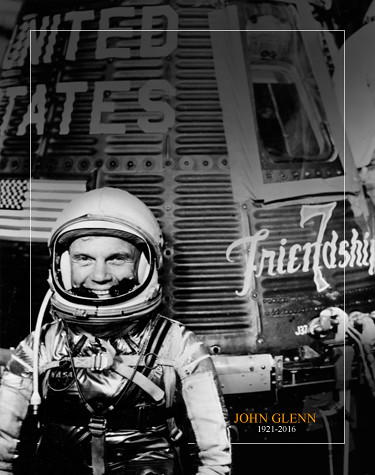
Volume XII, Issue XIXa
America mourns the passing of Astronaut John Glenn, the first American to fly in Earth orbit. He was born in Cambridge Ohio in 1921. He entered the Naval Aviation Cadet Program in 1942. Commissioned in the Marine Corps in 1943, he flew 59 combat missions. He then served in the Korean War.
He was selected as one of the original seven Mercury Astronauts and was the first to fly on the Mercury-Atlas into orbital flight. Originally cleared for a longer mission, his flight was cut to theree orbits when a warning light indicated that the heat shield had possibly come loose. The heat shield was supposed to do that after reentry as their was a cushion sack to soften the landing into the ocean, but if it came loose before reentry, the craft could be burned up.
NASA engineers decided to keep the heat shield in place by not jettisoning the retro-rocket pack, strapped over the heat shield, that slowed the craft from orbital velocity for reentry. Glenn describes the glow of the melting retro pack outside the spacecraft window as: "a real fireball!" Glenn landed safely. The American space-age had fully begun.
But the Astronauts, like John Glenn, were simply the most visible heroes in a team of thousands who worked together to achieve a new leap in human exploration. There were other pioneers as well, such as the women of Langley Research Center's West Computing Division such as Katherine Johnson, Dorothy Vaughan and Mary Jackson.
These ladies broke barriers not only in their calculation of launch windows and trajectories, but in pushing new frontiers in opportunity for achievement. Their story is told in the upcoming movie: Hidden Figures [click to read] coming out this Winter.